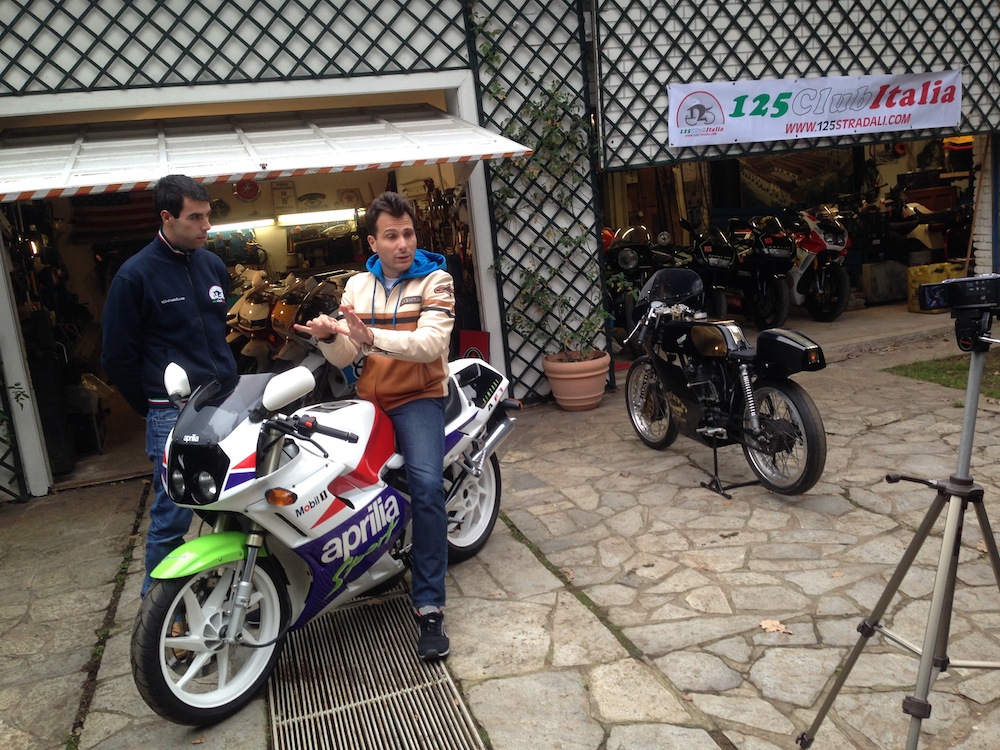Personalmente, ho iniziato ad interessarmi al mondo delle moto d’epoca quando avevo 16 anni e la prima moto che comprai fu una MV Agusta 125 Sport del 1976 che alternavo alla mia Honda NSR-R 125 del 1993. Poi quando i miei coetanei compravano le moto che allora si vedevano nuove dai concessionari, il mio interesse si era già spostato sulle giapponesi classiche che allora erano giusto delle moto vecchie. Honda CB Four e CBX sei cilindri, Suzuki GT 750, Kawasaki Z900 e MachIII oltre a più recenti anni 80 come Honda NS 400, Kawasaki GPZ Turbo, Suzuki GSXR 1100, insomma, le ho avute un pò tutte prima che queste venissero considerate d’epoca e purtroppo per me, le ho rivendute tutte proprio appena prima che i loro valori, in certi casi, esplodessero.
Intorno al 2002, era appena entrato in scena l’euro, avevo la possibilità di portarmi a casa una Honda RC30 in condizioni praticamente perfette al prezzo di 8000 euro e poco dopo trovai una Suzuki RG 500 Gamma a 3500 euro, un euro per ogni km originale che aveva. Pur riconoscendo la grande qualità del mezzo in questione (RC30), in più di uno molti amici collezionisti del tempo mi sconsigliarono dall’acquisto perché a sentir loro le giapponesi collezionabili dovevano avere le ruote a raggi e le uniche 2T collezionabili erano le Kawasaki Mach. Ero giovane e la qualifica di “spugnetta per francobolli” a tempo pieno (inclusi i weekend) che avevo nella megaditta, non mi permetteva di distrarmi più con le moto, quindi decisi di soprassedere dal loro acquisto. Certamente, con il senno di poi, è facile darsi del pirla.
Il punto è che avevo in sostanza anticipato i tempi, andando a mettermi in garage moto che non appartenevano alla mia generazione. Quindi, sebbene le amassi e apprezzassi, in una qualche misura non mi appartenevano. Fu così, che nel lontano 2007, la passione mai sopita per le moto per eccellenza della mia adolescenza, mi assalì completamente e così mi ricomprai la mia NSR 125 subito seguita dalla Aprilia Futura 125 del 1990 che in quegli anni sognavo molto intensamente. Poco dopo nacque 125stradali.com e come si dice, il resto è storia.
Mi sono quindi spesso posto diverse domande sul collezionismo, sul perché siamo spinti a collezionare certi tipi di moto, su quale sia effettivamente il loro valore, se il loro valore abbia importanza o pure meno, su quali moto val la pena di spenderci dietro soldi pur sapendo che molto spesso ripristini e restauri superano di gran lunga l’effettivo valore economico della moto che ne è oggetto.
Dopo oltre venti anni che sono del mestiere, francamente credo di poter darmi delle risposte. Ma ho sentito il bisogno di confrontarmi con un professionista che fosse in una qualche misura un pò fuori dalla “125 mania” che pare aver nuovamente contagiato il nostro paese. Quindi chi meglio dell’amico Jim Moore, direttore della rivista inglese leader Practicalsportsbikes, grande cultore e fine conoscitore delle moto anni 80-90, ma soprattutto, un grande appassionato motociclista (che vedete in sella alla Cagiva Mito Denim sopra).
Per il momento, vi lascio l’intervista in lingua inglese, conscio che il livello non sia così complicato da comprendere, magari con l’aiuto di google traduttore.
125stradali: What makes a motorbike collectable?
Jim: In the loosest sense, any motorbike can be collectable if it appeals to an individual, but more collectable models tend to have or be one of the following: nostalgic appeal because they were popular when new, such as 50s and 125s.
Exotic bikes, such as Sports Production and homologation models, have become very collectable – RC30 Hondas, OW01 Yamahas, 916 SPS Ducatis are examples of these, and their values have really rocketed in recent years. Because of this they are also seen by many collectors as ‘investments’.
Then there is rarity. The fewer of a model there are – either because of small production runs or simply because only a few are left in existence – the higher the potential value and appeal to a collector. Two-strokes have climbed sharply in value since the production of them stopped because there is now only a finite number of them left.
125stradali: Does the equation more cc = more expensive always hold true for modern classic motorbikes? We often hear comments like “with that sort of money, I’d rather buy a 600cc or a bigger bike”?
Jim: In short, no. Cubic capacity has little relevance to values if you look at the old bike market. In the UK, for example, 250cc two-strokes have doubled and in certain cases tripled in value in recent years. A decade ago you could buy a tidy Honda NSR250 MC21 for under £3000. Now you will pay anything up to £6500. This is partly due to dealers being opportunist with their pricing, and also because the stock of good 250s in Japan in particular is shrinking. In fact after years of selling their used 250s to the UK and Europe, Japan has finally realized that it would like to keep some of these bikes, and that has increased values too.
Nostalgia has done much to increase prices. In the UK, many middle-aged men (like me) want to relive their care-free teenage days, and one way to do that is to buy a 50 like the one they had when aged 16. Mopeds from the 1970s became very popular – Yamaha FS1-Es, Suzuki AP50s etc – and this pushed prices through the roof. People were – and still are – paying up to £5000 for an FS1-E, which is crazy because you could buy two Honda FireBlades for the same money.
Surprisingly then, sports 600s are very cheap in the UK, despite being very popular in the 1990s. The 600s were always built down to a price – they were never as exotic or well-made as Japanese market 400s – so their values now continue to reflect that. Some of the big 1000cc machines, like Yamaha FZR1000 and GSX-R1100s can still be bought cheaply but early FireBlades (1992) and first generation YZF-R1s (1998) are now very collectable in the UK and are commanding strong money. Collectors like ‘first year’ models and these always command a higher value than later and usually better versions of the same bike.
125stradali: How do you see the market for Italian 125cc for the 80s and 90s? Do you see it as a more local (Italian) fashion or could it be something wider?
Jim: There is a big nostalgia for small bikes in the UK, as in Italy, but it tends to be around Japanese models because those were the bikes we rode. In UK we were allowed to ride 50cc bikes at 16 and 125s at 17. If you passed your motorcycle test at 17 you could ride anything, as long as you could afford the insurance. Our 50cc bikes were supposed to be restricted to 30mph, but almost all the bikes were derestricted or fitted with big-bore kits (65cc) or 80/100cc engines so we could ride at 50-60mph. Popular bikes were Kawasaki AR50s, Honda MB-5s, Yamaha DT50s and Suzuki TS50s. All of them are now popular again with guys of my age (40s).
At 17 our 125s were supposed to be restricted to 12bhp but, again, we derestricted them and made them full power. Yamaha’s RD125LC and DT125LC were the most popular bikes by far. Honda imported the Italian built NS125F/R and NSR125R, which were fairly popular but never as fast as the later TZR125 2RK. Gileras were imported in small numbers (bikes like RX and RV) but the Italian 125s never really caught on until Aprilia brought in the AF1/RS and Cagiva imported the Mito.
Italian 125s were much more expensive than Japanese bikes, and while fast and flashy they were seen as fragile, so only the ‘rich’ kids had them. There is a nostalgia for them here in the UK though, and we’ve done a few features in Practical Sportsbikes about people restoring AF1s – there are always some for sale on eBay, too.
125stradali: As different generations age out, their cars do, too. However, while the owners may die, the motorbikes don’t. They don’t become worthless, but there’s a shift in the types of people who buy them and the types of collections where they go. What is your view?
Jim: Yes, this is true, and we’ve already seen it with the British bikes. The guys who rode Nortons and Vincents back in the day are now in their 60s and 70s. Many of them are now too old to ride and that unfortunately means that many of the bikes they now own are not ridden. It’s a shame that many of these bikes have now become a) too valuable to ride or b) nothing more than museum exhibits.
It is therefore important that we get the youth of today interested in our bikes so we can pass them on for younger generations to enjoy.
125stradali: Each generation has got their motorbikes, true. However, in the late 90s I started to collect 70s Honda Fours and CBXs, Kawasaki Zs and Machs, Suzuki GTs… I think I was the only 20s years old kid who was into that heavy old metal! Today, however, I begin to see people of my age who do love bikes who sometimes are much older than their date of birth, like Guzzis and Gileras for instance. I think that a real collector ages like good wine: the more time you study a topic, the more time you spend on a subject, the easier may become to like something that you did not know you might have liked.
Jim: I think there is a certain fact that all of us with a love for petrol-powered cars and bikes have to face, and it’s this: electric bikes and cars are coming and within 20-30 years vehicles with internal combustion engines will be a rare sight on our roads. I think this is causing a post-nostalgia among the young – they realise that the time to enjoy a petrol-powered car or bike is now. They and we are witnessing the end of an era. We were lucky enough to live through the two-stroke age, and we keep that age going with our nostalgia. The same will happen for the engine in general, and for vehicles like 70s/80s Guzzis and the like with no computers or rider aids. That was an era of mechanical purity and I can see why that would appeal to the i-pad generation – it is a completely new and different experience for them, and one we should encourage.
Conclusioni… ci proviamo!
Sebbene non sia titolato come Jim e sia un semplice appassionato e non un professionista del settore, come dicevo all’inizio, sono oltre 20 anni che gioco con le moto d’epoca ed il mondo che ci ruota intorno. Quindi permettete anche al sottoscritto qualche considerazione ragionata cercando di rispondere alla domanda iniziale “quanto vale una 125 anni 80 e 90”.
Come abbiamo visto, esistono diversi tipi di collezionista, ma a mio avviso la vera discriminante tra un tipo e l’altro, sono generalmente la cultura ed il proprio carattere. Ognuno di noi è diverso, quindi ognuno ha il suo approccio al collezionismo. Senza scendere troppo nelle tantissime categorie, mi permetto di provare a rispondere alla domanda che ci siamo posti ad inizio articolo, con gli occhi di un motociclista-collezionista che è la categoria alla quale mi sento di appartenere. Questa curiosa specie, infatti, trae piacere dagli oggetti che colleziona solamente portandoli su strada ed apprezzandone le doti dinamiche, non è quindi un accumulatore seriale e ne tantomeno uno di quelli che la moto la metterebbe in salotto. Un luogo dove vedere una moto mi fa francamente schifo! Sono un patito del conservato perfetto con doppie chiavi, libretti, attrezzi, targa originale (possibilmente MI), ma con motore e ciclistica portati a zero ore. Non cambierei mai uno specchietto o freccia originale con un aftermarket e sono abbastanza scafato dal sapere che moltissime componenti di una moto (forcelle, pinze freno, carburatore, ecc) sono marchiate con l’anno di produzione. Arrivo quindi alla follia che controllo che le varie parti della moto siano coeve con l’anno di produzione, guai ad avere un piede forcella marchiato “95” su di una moto prodotta nel ’93. Non dormirei alla notte. Detto questo, non me ne frega nulla di cambiare i tubi freno in gomma con eleganti tubi in treccia neri e raccordo in alluminio o di mettere le migliori e più recenti gomme. Questo perché sono un motociclista e non un kamikaze.
Ma allora quanto vale una 125?
In genere una bella 125 anni 80 e 90, ottimamente conservata, nel 2022 vale in media sui 4/6000 euro. Alcune 125 prodotte in numeri estremamente ridotti, come certe SP, sono state vendute per prezzi prossimi ai 10.000euro. Possono valere di meno? Di più? Non lo so. Alla fine tutto sempre dipende da quanto vuole investire un potenziale acquirente.
La domanda che mi pongo è se tra trent’anni, quando i 40-50 enni che oggi le ricercano e le ricomprano saranno dei vecchietti, il mercato avrà ancora interesse per loro. Non posso darvi nessuna certezza, ma sono abbastanza sicuro che, salvo possibili sconvolgimenti finanziari sempre in agguato, i valori continueranno a salire. Mai in linea retta (niente cresce per sempre), quindi con possibili e salutari storni nei prezzi. Ad ogni modo, come scritto da Jim, noi rappresentiamo l’ultima generazione cresciuta con i motori a scoppio che tra 20/30 anni saranno quasi completamente pensionati dalla nuova tecnologia. Vi lascio quindi con un punto aperto: nel mondo, soprattutto fuori dall’Europa, il numero di ricchi cresce a ritmo impressionante. Si stima che da qui a qualche anno cresceranno del 46% a livello mondiale. Ebbene, il collezionismo è spesso cosa riservata a chi ha soldi da buttare o da investire, dipende dai punti di vista. Quindi, tra i nuovi milionari, qualcuno di loro amerà sempre i motori e comprerà auto e moto a scoppio anche quando magari non si venderanno più da nuove, quando saranno un pò come oggi vediamo la tecnologia a vapore. A mio avviso, qualcuno che ama i due tempi ci sarà sempre e visto che le 125 nostrane sono state quanto di meglio possa esistere a testimonianza di quel periodo, la legge della domanda e dell’offerta prevarrà. Se così non fosse, ciò non dovrebbe interessare troppo un appassionato: GODETEVI le vostre moto USANDOLE SU STRADA. E che vadano a quel paese le considerazioni economiche!
125 lampeggi
Ps
Un buon articolo non può che finire con un PS. Quindi… a coloro che spesso scrivono a spoposito “chiede più soldi di quanto costava da nuova”, divertitevi pure con questo simpatico giochino Istat che vi da la possibilità di quantificare quanto valore hanno perso i nostri soldi, causa la svalutazione . Così vedrete che, ad esempio, una Gilera SP01 che nel 1989 costava Lire 5.900.000, oggi equivarrebbero a Lire 11.941.600 ovvero a Euro 6.167,32






